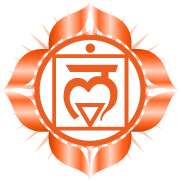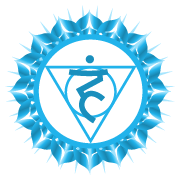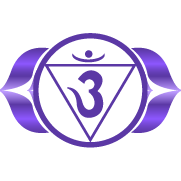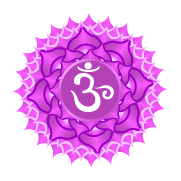Second chakra or Swadhisthana: the sacred center

The Second Chakra is designated by the name of Swadhisthana (from the Sanskrit swa, “the proper” and adhisthana “abode”). It is also known as the sacred center.
Located in the pubic region, on the genitals (between the fifth lumbar vertebra and the sacrum bone), Swadhisthana is identified with the creative principle of being, the center of primary, unprocessed emotions.
Swadhisthana represents the affirmation of security, the ability to give and receive love, the manifestation of sexual and reproductive energy, creativity, imagination, desire and enthusiasm.
In the physical body, Swadhisthana governs the sexual reproduction organs, kidneys, bladder, lower intestine, testosterone, progesterone, estrogen, and together with Muladhara, the male prostate and blood.
The second chakra, Swadhisthana
When the sacral center works harmoniously, the individual eliminates sexual complexes and lives freely with enthusiasm, vitality and creative ability developed. The sexual union is fully enjoyed and seen as the integral relationship between bodies and spirits.
The excess of energy in Swadhisthana is reflected in a vision of life as a selfish system of complacency, unsatisfied recurring desires, extreme anxiety, reactivity, exhaustion, anger and promiscuity.
Similarly, the low energy in Swadhisthana brings apathy and the non-existence of objectives or dreams.
A blockage in Swadhisthana can result in inability or difficulties in reaching orgasm, painful sexual relations, premature ejaculation, erectile dysfunction, little sexual impulse or repression of the instinct of attraction, fear of pleasure, repressed personality, accumulation of feelings of guilt and humiliation.
Reactivating the Swadhisthana
To achieve the cleansing and activation of Swadhisthana, specialists recommend meditation, using the image of the Moon (especially the Full Moon), and the observation of natural water courses. This last exercise invites the flow of stagnant energy.
Likewise, we can proceed to listen to rhythms that induce feelings of joy in ourselves, and the vocalization of the VAM mantra directly associated with the energy of Swadhisthana.
Other formulas include the use of chromotherapy, with representations of the orange color (the tone of Swadhisthana); the use of moonstone, coral or carnelian as amulets, and essential oils of sandalwood, camphor, ylang ylang, rose, amber or rosemary.
The essences can be perceived by smell or applied to the chakra, following the clockwise direction to the right in the case of women, and counterclockwise (to the left) for men.
The practice of tantra, belly dance and exercises that link hip movement, generate a positive impact on Swadhisthana, as well as swimming, hydrotherapy techniques and the conscious expression of emotions.
The Chakras Explained
Get to know everything about all the 7 chakras bellow.


Muladhara
The First Chakra, which is the first of the seven main chakras, is designated by the name of Muladhara (from the Sanskrit mule “root” and adhara “support”). It is also known as radical chakra, root chakra, basal chakra or coxal center.
Read more

Swadhisthana
The Second Chakra of the seven main chakras is designated by the name of Swadhisthana (from the Sanskrit swa, “the proper” and adhisthana “abode”). It is also known as the sacred chakra or sacred center.
Read more

Manipura
An interiorized symbol of solar energy, the third chakra or Manipura is the seat of the Ego and our self. Through it we can affirm our individuality and exercise our free will to build our own life.
Read more

Anahata
The Fourth Chakra of the seven main chakras, is designated by the name of Anahata, which in Sanskrit refers to something that has not been touched, the sound produced by two elements that meet but do not collide. It is also known as heart chakra, cordial center, and unconditional love chakra.
Read more

Vishuddha
The fifth chakra is also called throat chakra, or laryngeal chakra. Its Sanskrit name is Vishuddha, meaning “pure”. The problem of the 5th chakra is bound to express its truth in a fair way. This requires that chakras 1 to 4 be well balanced. Located in the throat, between the laryngeal (or nut) prominence and the larynx, Vishuddha represents the link between thoughts and emotions, the way of expressing and communicating.
Read more

Ajna
The 6th chakra, Ajna, is also called the frontal chakra or 3rd eye. It is the chakra of the inner vision and the extrasensory perception. The 3rd eye allows psychics and therapists to see the aura, to go back into past lives, etc.
Read more

Sanskrit
The seventh chakra is also called Sahasrara, which in Sanskrit language means “multiplied by a thousand”, a clear reference to the lotus of a thousand petals symbol of Illumination. It is the chakra of knowledge, consciousness, intelligence and humility.
Read moreYou may also like:
- Aura cleansing ritual: why you should do it
- Healing gemstones: the most popular
- Forest bathing: why you should try it

